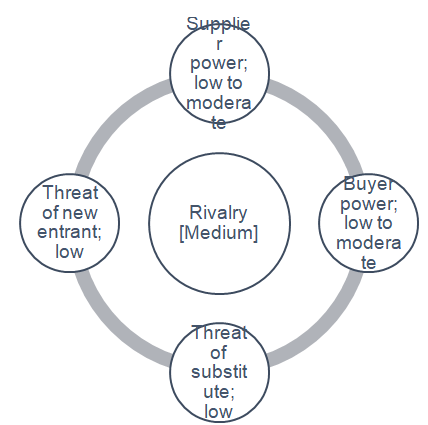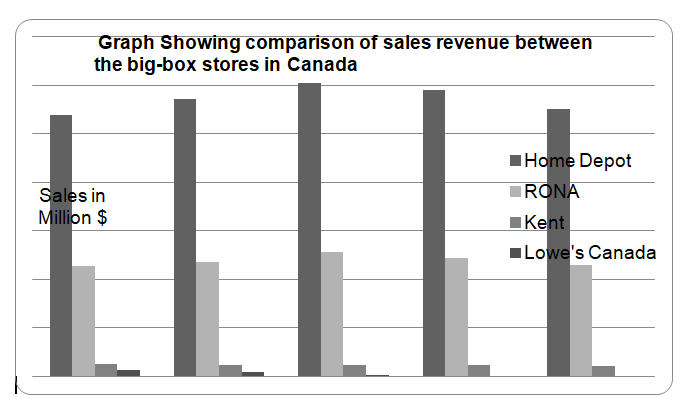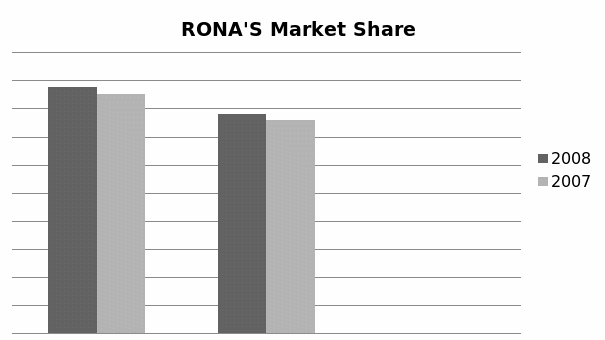Introduction
Since its inception, RONA has managed to dominate the Canadian Hardlines market by establishing a comprehensive distribution network. The stores operate under different formats and sizes. RONA focuses on nurturing a high level of flexibility and adapting its stores to the diverse customer needs. The firm witnessed remarkable growth from 2000 to 2006.
One of the factors that enhanced the firm’s growth is the incorporation of a rapid expansion strategy. The firm’s sales revenue increased from $ 1,289 million to $ 4,552 million during this period, which represents a relatively high growth rate.
Problem statement
Despite its strong financial performance, RONA was affected adversely by the 2007 recession. First, the firm experienced a decline in the rate of growth in some of its Canadian markets such as the western region, which was occasioned by a decline in the consumers’ purchasing power. The level of consumer spending on home improvement declined considerably.
Furthermore, the firm’s performance exacerbated after the decline in demand within the automobile industry. The prevailing market trends also presented a major challenge in the firm’s survival. Consumers were increasingly focusing on the service level provided rather than the store format or size. Moreover, consumers were becoming environmental conscious in an effort to minimize the occurrence of climate change.
In a bid to survive in an environment characterized by a high rate of climate change, RONA was required to adjust its operations to align with the changing consumer behaviors. One of the strategies that the firm had to implement entailed integrating the concept of sustainable development.
In addition to the above challenges, the industry experienced a high rate of technological change. Therefore, its ability to achieve competitive advantage amidst the challenges faced depended on the extent to which it adjusted its operational processes.
Analysis
Organizations are exposed to different challenges emanating from the macro and microenvironments. Examples of such challenges arise from market changes such as increase in the intensity of competition and change in consumer purchasing behavior. The challenges might affect the competitiveness of a firm adversely if effective strategies are not implemented.
It is imperative for organizational leaders to develop a comprehensive understanding of the internal and external business environments. Gaining such insight forms a strong foundation in organizations’ effort to deal with external and internal changes. This can be achieved be achieved by integrating different internal and external market analysis models. Below is an analysis of RONA’s internal and external environments.
External analysis
The level of competition in a particular industry is subject to the changes in the competitive environment.
Conducting a structural analysis of a firm’s industry is an important source of insight to organizational managers in their quest to ensure that their organizations achieve the desired competitive advantage (Henry, 2011). The Porter’s five forces is one of the frameworks that an organization can integrate in evaluating the industry.
Threat of new entrants
The Canadian hard-lines industry is characterized by low threat of new entrants courtesy of the high cost of entry. A number of big box companies such as RONA, which have successfully established their operations in the market, dominate the industry. RONA has a strong market position in Ontario and Quebec.
By 2009, the firm was ranked second amongst the big-box stores with regard to sales.
Buyer bargaining power; [low to moderate]
A large number of consumers characterize the Canadian market. Secondly, few big-box retailers pose a threat to RONA’s operation. The few big-box retailers in the market [Home Depot, Canadian Tire Corp., and Home Hardware] do not offer services similar to those offered by RONA.
The large number of customers coupled with the high demand in the Canadian hard-lines market makes it hard for consumers to push the price down (Richard Ivey School of Business, 2009).
Supplier power [low to moderate]
Most suppliers in the Canadian hard-lines market do not have a substantial advantage. Subsequently, their operations do not have a substantial effect on the product prices.
The firm’s large size has significantly diminished suppliers’ power. RONA can easily control the price of its products. RONA has over the years concentrated on developing a strong relationship with the suppliers. Therefore, the firm’s relationship with its suppliers may be affected if it shifts to other suppliers.
Threat of substitutes [low]
There are relatively low substitutes to hard-lines products in Canada due to the few retailers in the industry. In its quest to minimize the threat of substitute, RONA has integrated a comprehensive product differentiation strategy.
Degree of rivalry [medium]
RONA faces competition from a number of big-box stores such as Home Depot, Kent, Canadian Tire Corporation, and Lowe’s Canada. Despite the intense competition, RONA has been in a position to differentiate its product and services successfully. The flow chart below depicts a summary of RONA’s industry structure.

Internal analysis
VRIO Framework
Developing sufficient competitive advantage is critical in an organization’s effort to attain long-term survival. Integrating the resource-based view [RBV] is one of the avenues through which an organization might achieve the desired level of competitive advantage. This goal is attainable by basing the competitive advantage on rare, valuable, organizational, and inimitable resources.
Valuable
Cardeal and Antonio (2012) argue that the ability of an organization’s resources to create value is dependent on their capacity to facilitate the formulation and implementation o operational strategies that will contribute towards attainment of a high level of efficiency and effectiveness.
One of the most evident attributes that give the Canadian hard-lines’ market a high value is that more than 80% of all home in Canada are more than 15 years old. These houses require major renovation in the near future, which indicates a high market potential for hard-lines companies such as RONA.
A large number of baby-boomers, who are nearing their retirement age, currently characterize the Canadian population. A significant proportion of Canadians within the baby-boomers age group consider renovating their homes as a worthy hobby.
Furthermore, a significant proportion of the baby-boomers prefer the Do-It-For-Me model. This aspect presents a perfect opportunity for RONA to increase its sales revenue by offering installation services, which were launched in 2005. Therefore, the market fundamentals are appealing.
The store also creates value by integrating a flexible operational strategy by integrating different formats and ownership structures. Its strategy to pursue the independent dealers has substantially enhanced the firm’s value. The organization has recruited approximately 5,000 dealers in Canada who account for 54.6% of the market (Richard Ivey School of Business, 2009).
In an effort to improve its financial performance, RONA has formulated an effective strategy to enable the dealers improve their performance. This has been achieved through integration of a comprehensive employee training and motivation program. The strategy has played a fundamental role in improving RONA’s operational efficiency and market dominance.
Rare
In an effort to attain differentiate itself, RONA considers its stores distributed in different parts of the country as a product. The decision to adopt this strategy was necessitated by recognition of the view that the store layout plays a critical role in promoting customer experience (Kazmi, 2008).
RONA is ranked as the first Canadian Hardlines retailers to show its commitment towards replacing its big-box store format in an effort to cope with the changing consumer attitude.
RONA focused on improving its store ambience by integrating effective store designs by ensuring that the stores were decorated effectively, well lit, and spacious. Furthermore, the firm also integrated appealing signage in an effort to direct customers within the store.
Adopting eco-initiatives is another strategy that allowed the firm to attract customers. This strategy is in line with the change in the consumers’ perception on the importance of protecting the environment by minimizing greenhouse gases’ emissions.
The firm has also integrated other programs such as the RONA by Design, RONA-certified professionals, and RONA Project Guide, which are aimed at providing optimal level of customer service.
Inimitable
RONA has adopted a comprehensive differentiation strategy in an effort to distinguish itself from competitors. The firm has based its competitive advantage on the services that it offers to its customers. The firm has developed an employee-training program in an effort to ensure that its customers receive high quality customer services. The training program has led to the adoption of best practices within its workforce.
Organization
The firm has based its operational processes on the prevailing market conditions. For example, the firm has exploited the Do-It-For-Me attitude amongst the Net Geners by developing an Installation Service as one of its products. Furthermore, the firm has taken into account the factors that influence the Canadian consumers in their buying process.
RONA has identified the female gender as one of the major determinants in the purchase of household products in Canada. Subsequently, the firm has targeted women by creating a ‘feminine friendly environment’. The firm presents its products in boutiques. Therefore, the firm has successfully influenced the female gender.
SWOT Analysis
The chart below illustrates a summary of the firm’s strengths, weaknesses, threats, and opportunities
Financial analysis
The Canadian Hardlines industry was affected adversely by the recession. Most consumers experienced a decline in their purchasing power due to loss of employment. The recession led to a decline in the level of uncertainty regarding the country’s future economic performance (Grusky & Western, 2011).
The level of confidence amongst the Canadian consumers declined from over 100, in January 2002, to below 70, by January 2009. Despite this decline, RONA was in a position to sustain a relatively high financial performance during the period (Richard Ivey School of Business, 2009).
The chart below illustrates the firm’s performance with respect to sales from 2005 to 2009. From the chart, it is evident that RONA had a relatively strong performance compared to other firms.

The firm is focused towards improving its makret dominanace by increasing its makret share. Subsequently, the firm estimates its desired financial position for a particular year. The recession affected the firms ability to attain the set target. The figures below illustrate the estimated and the actual sales and makret share during the period ranging from 2007 to 2008.

Furthermore, the firm was not able to achieve its sales target in 2007. However, its sales revenue increased to $ 40.3 million because of adoption of an optimal operational and marketing strategy.

RONA had a strong financial performance during its growth phase. Its net income increased from $18 million in 2000 to $190 million in 2006. However, this performance was affected by the recession. Its net income declined to $185 million and $160.2 million in 2007 and 2008 respectively. The graph below illustrates the firm’s performance with regard to net income from 2000 to 2008.

The recession had adverse effects on the firm’s cash flow. For example, its net change in cash flow in 2007 and 2008 was $ 9,480 and $ (55, 620).
Evaluation of alternatives
In its quest to stimulate financial performance during and after the recession, RONA intends to implement two main programs, which include the PEP and the Recovery programs. Re-launching the PEP program will focus on improving the firm’s level of productivity, profitability, and efficiency. In a bid to achieve this goal, RONA will be required to undertake a number of projects, which include
- Improve the level of profitability in its corporate store network
- Optimize its supply chain
- Improve the recruitment of independent dealers
- Promote customer loyalty
Despite the view that implementing the PEP program would contribute towards development of RONA’s competitive advantage, the firm will incur high cost in the process of implementing the projects.
The financial analysis shows that RONA is experiencing a challenge in its financial performance due to the recession. Thus, the likelihood of the firm facing a challenge in its quest to re-launch the PEP program is high (Richard Ivey School of Business, 2009).
Adopting the recovery program is more effective in enhancing the firm’s ability to deal with the recession. The recovery program would enhance the firm’s ability to stimulate its growth vectors, which had been distracted by the recession.
Furthermore, implementing the recovery program will stimulate the firm’s business model. For example, the firm will be in a position to venture into new markets by establishing independent dealers. Subsequently, RONA will improve its market dominance.
Conclusion
From the case study, it is evident that the 2007 recession had adverse effects on the performance of firms in the Canadian Hardlines industry. Furthermore, the case depicts a high market potential within the Canadian Hardlines market due to the prevailing market dynamics. One of the sources of market potential relates to the attitude of the Canadian consumers towards renovation, gardening, and decoration.
Most Canadians consider decoration, renovation, and gardening of their homes as an important component of their hobbies. This trend is mainly evident amongst the baby-boomer. Furthermore, most Canadians, especially the baby-boomers have adopted the DIFM model, which presents a perfect opportunity for RONA to expand its market with regard to the provision of installation services.
The case study further shows that RONA can improve its competitive advantage by focusing on its internal and external business environments. RONA has optimally positioned itself in the Canadian market. Therefore, the firm should focus on improving its competitive advantage. The firm can improve its competitiveness by focusing on its differentiation strategy.
One of the ways through which the firm can achieve this goal is by integrating the concept of new product development. However, the success with which the new products penetrate the market will depend on the quality of the market research conducted. The product or service developed should align with the customers’ needs, tastes, and preferences.
The VRIO framework shows that RONA has the capability to recover fully from the recession. However, this aspect will depend on the effectiveness with which the firm exploits its internal capabilities and resources.
Recommendations
In order to deal with the recession successfully, RONA should consider the following
Open the recovery program– the firm should mainly focus on implementing the recovery program rather than opening the PEP program. The rationale for selecting this decision is based on the view that the firm has already developed sufficient competitive advantage.
Subsequently, it is imperative for the firm to leverage on its strengths in order to improve its share price. Implementing the recovery program will improve the firm’s sales, which had declined substantially. The case analysis also shows that there is a high probability of an upturn in the Canadian’s economic performance. This projection further diminishes the probability of implementing the PEP program.
Market expansion- the analysis shows that RONA has mainly concentrated its operations in Canada. The firm should consider expanding its operations by integrating the concept of internationalization. However, the firm should conduct a comprehensive market research in order to identify the markets with the highest potential.
Implementation
RONA should adopt the recovery program. However, the program should be implemented in phases. For example, the first phase should have commenced in 2009 to 2011. Secondly, RONA should focus on enhancing its growth vectors.
Recruiting additional dealers and increasing the firm’s comparable sales should be the first stage and should be undertaken concurrently. This process should be undertaken between 2009 and 2010.
Some of the activities that should be undertaken during this phase entail providing customers with value added services and renovating 20% of its store network within one year. This move will contribute towards improving the firm’s operational efficiency and effectiveness.
The second phase of recovery should entail constructing additional stores and seeking more Hardlines firms to acquire within and across the borders. The rationale for implementing these projects in the second phase emanates from the view that the firm will have generated additional revenue to implement them.
Mostly, firms fail in their implementation strategies due to lack of enough resources, but given that the implementation comes in the second phase, RONA will be prepared and readily equipped with the necessary resources.
The firm should conduct a comprehensive market research in order to identify the markets with the highest potential. Furthermore, the firm should consider acquiring firms with a high degree of fit with RONA, which will aid in minimizing integration challenges.
Reference List
Cardeal, N., & Antonio, N. (2012). Valuable, rare, inimitable resources and organizations. African Journal of Business Management, 6(37), 10159-10170.
Grusky, D., & Western, B. (2011). The great recession. New York, NY: Sage.
Henry, A. (2011). Understanding strategic management. New York, NY: Oxford
University Press.
Kazmi, A. (2008). Strategic management and business policy. New Delhi, India: Tata McGraw-Hill.
Richard Ivey School of Business: RONA Inc.-dealing with recession. (2009). London, UK: University of Western Ontario.